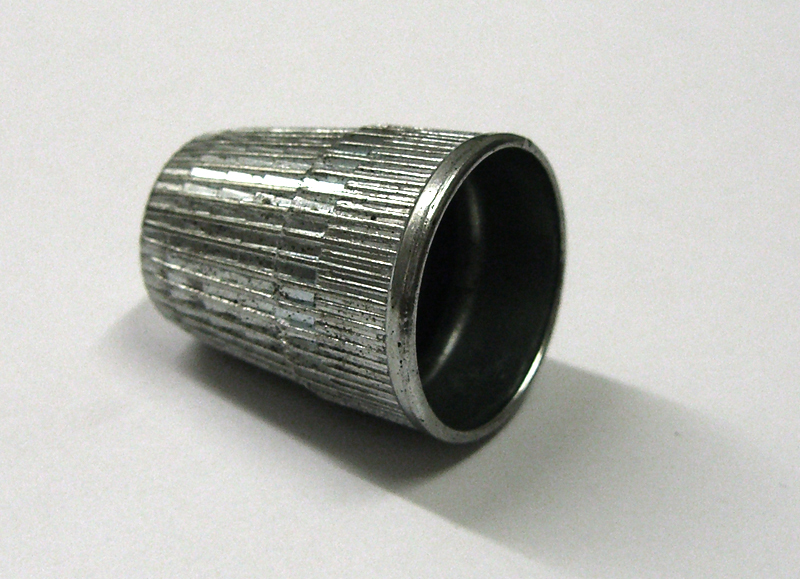|
Washboard (musical Instrument)
The washboard and frottoir (from Louisiana French "frotter", to rub) are used as a percussion instrument, employing the ribbed metal surface of the cleaning device as a rhythm instrument. As traditionally used in jazz, zydeco, skiffle, jug band, and old-time music, the washboard remained in its wooden frame and is played primarily by tapping, but also scraping the washboard with thimbles. Often the washboard has additional traps, such as a Woodblock (instrument), wood block, a cowbell (instrument), cowbell, and even small cymbals. Conversely, the frottoir (zydeco rubboard) dispenses with the frame and consists simply of the metal ribbing hung around the neck. It is played primarily with spoon handles or bottle openers in a combination of strumming, scratching, tapping and rolling. The frottoir or ''vest frottoir'' is played as a stroked percussion instrument, often in a band with a drummer, while the washboard generally is a replacement for drums. There is a Polish tradition ... [...More Info...] [...Related Items...] OR: [Wikipedia] [Google] [Baidu] |
Carolina Chocolate Drops
The Carolina Chocolate Drops were an Old-time music, old-time String band (American music), string band from Durham, North Carolina, Durham, North Carolina. Their 2010 album, ''Genuine Negro Jig (album), Genuine Negro Jig,'' won the Grammy Award for Best Traditional Folk Album at the 53rd Annual Grammy Awards, and was number 9 in ''fRoots'' magazine's top 10 albums of 2010. Career Formed in November 2005, following the members' attendance at the first Black Banjo Gathering, held in Boone, North Carolina, in April 2005, the group grew out of the success of Sankofa Strings, an ensemble that featured Dom Flemons on bones (instrument), bones, jug (instrument), jug, guitar, and four-string banjo, Rhiannon Giddens on banjo and fiddle and Súle Greg Wilson on bodhrán, brushes, washboard (musical instrument), washboard, bones, tambourine, banjo, banjolin, and ukulele, with Justin Robinson as an occasional guest artist. All shared vocals. The purpose of Sankofa Strings was to present a ... [...More Info...] [...Related Items...] OR: [Wikipedia] [Google] [Baidu] |
Spoon (musical Instrument)
Spoons can be played as a makeshift percussion instrument, or more specifically, an idiophone related to the castanets. They are played by hitting one spoon against the other. Techniques # Fire tongs style: A pair of spoons is held tight with concave sides facing out and with index finger between their handles to space them apart. When the pair is struck, the spoons sharply hit each other and then spring back to their original position. The spoons are typically struck against the knee and the palm of the hand. The fingers and other body parts may also be used as striking surfaces to produce different sounds, rhythms, rattles and visual effects. # Salad serving style: One spoon between little, ring, and long finger; the other spoon between ring, thumb, and index finger in such a way that they can be rotated with ring finger as the common axis. They can be hit to each other at the convex sides by gathering the fingers (mostly middle and thumb). # Castanets style: Two in eac ... [...More Info...] [...Related Items...] OR: [Wikipedia] [Google] [Baidu] |
Jug (musical Instrument)
The jug used as a musical instrument is an empty jug (usually made of glass or stoneware) played with buzzed lips to produce a trombone-like tone. The characteristic sound of the jug is low and hoarse, below the higher pitch of the fiddle, harmonica, and the other instruments in the band.smithsonianfolkways: The Jug Bands Compiled and edited by Samuel Charters Performance With an like that used for a[...More Info...] [...Related Items...] OR: [Wikipedia] [Google] [Baidu] |
Jug Bands
A jug band is a band employing a jug player and a mix of conventional and homemade instruments. These homemade instruments are ordinary objects adapted to or modified for making sound, like the washtub bass, washboard, spoons, bones, stovepipe, jew's harp, and comb and tissue paper. The term 'jug band' is loosely used in referring to ensembles that also incorporate homemade instruments, but those are more accurately referred to as skiffle bands, spasm bands, or juke (or jook) bands (see juke joint) because they do not include a jug player. History Early jug bands were typically made up of African-American vaudeville and medicine show musicians. Beginning in the urban South (namely, Louisville, Kentucky, and Memphis, Tennessee), they played a mixture of blues, ragtime, and jazz. The history of jug bands is related to the development of the blues. The informal and energetic music of the jug bands also contributed to the development of rock and roll. The jug sound is made by tak ... [...More Info...] [...Related Items...] OR: [Wikipedia] [Google] [Baidu] |
Hamboning
The Juba dance or hambone, originally known as Pattin' Juba (Giouba, Haiti: Djouba), is an African-American style of dance that involves stomping as well as slapping and patting the arms, legs, chest, and cheeks (clapping). "Pattin' Juba" would be used to keep time for other dances during a walkaround. A Juba dance performance could include steps such as the " Jubal Jew", " Yaller Cat", "Pigeon Wing" and " Blow That Candle Out". The dance traditionally ends with a step called the " Long Dog Scratch". Modern variations on the dance include Bo Diddley's "Bo Diddley Beat" and the step-shows of African American Greek organizations. History of the dance The Juba dance was originally brought by enslaved peoples from the Kongo to Charleston, South Carolina. It became an African-American plantation dance that was performed by slaves during their gatherings when no rhythm instruments were allowed due to fear of secret codes hidden in the drumming. The sounds were used in the same mann ... [...More Info...] [...Related Items...] OR: [Wikipedia] [Google] [Baidu] |
Washboard Busker
{{disambiguation ...
Washboard may refer to: * Washboard (laundry), a tool for washing clothes * Washboard (musical instrument), a percussion instrument * Washboarding, corrugation on gravel or dirt roads * Short for washboard abs, visible rectus abdominis muscle The rectus abdominis muscle, () also known as the "abdominal muscle" or simply better known as the "abs", is a pair of segmented skeletal muscle on the ventral aspect of a person's abdomen. The paired muscle is separated at the midline by a ba ... [...More Info...] [...Related Items...] OR: [Wikipedia] [Google] [Baidu] |
Latin Music (genre)
Latin music ( Portuguese and ) is a term used by the music industry as a catch-all category for various styles of music from Ibero-America, which encompasses Latin America, Spain, Portugal, and the Latino population in Canada and the United States, as well as music that is sung in either Spanish and/or Portuguese. It may also include music from other territories where Spanish- and Portuguese-language music is made. Terminology and categorization Because the majority of Latino immigrants living in New York City in the 1950s were of Puerto Rican or Cuban descent, "Latin music" had been stereotyped as music simply originating from the Spanish Caribbean. The popularization of bossa nova and Herb Alpert's Mexican-influenced sounds in the 1960s did little to change the perceived image of Latin music. In 1969, the first international organization which attempted to define Latin music was the Festival Mundial de la Canción Latina which included Spanish, Portuguese, French, a ... [...More Info...] [...Related Items...] OR: [Wikipedia] [Google] [Baidu] |
Newman Taylor Baker
Newman Taylor Baker (born February 4, 1943) is a jazz drummer and a Washboard (musical instrument), washboard player. Early life Newman Taylor Baker's paternal grandfather, Thomas Nelson Baker Sr., was the only former slave to receive a PhD from Yale University (1906). His father and siblings graduated from Oberlin College and Conservatory. Edith Baker (voice and piano), Ruth B. Baker (voice and piano), and Harry B. Baker (piano and organ), his aunts and uncle, were graduates of Oberlin Conservatory of Music. His maternal grandfather, Reverend Newman D. Taylor, known as the "Roland Hayes" of Mississippi, gave vocal recitals throughout the state and his uncle, Newman C. Taylor, accompanied him on piano. His aunt, India Taylor Johnson (a classmate of Dr. Billy Taylor at Virginia State University), was a vocal music and piano teacher in the Norfolk, VA public school system. His parents were Ruth Taylor Baker, born Yazoo City, Mississippi, and Dr. T. Nelson Baker, Jr., born Pittsfie ... [...More Info...] [...Related Items...] OR: [Wikipedia] [Google] [Baidu] |
The Washboard Rhythm Kings
The Washboard Rhythm Kings, also known as the Washboard Rhythm Boys (1932), Georgia Washboard Stompers (1934-1935), Alabama Washboard Stompers (1930-1932), Washboard Rhythm Band (1932-1933), and Chicago Hot Five were a loose aggregation of jazz performers who recorded as a group for various labels between about 1930 and 1935. Bruce Johnson played washboard. Career The band played good-time swinging music, featuring spirited vocals, horns, a washboard player and occasionally kazoo, and were popular around the time of the Great Depression. They mostly covered current hits from other artists. Their personnel varied considerably between sessions, with guitarist Teddy Bunn a regular member from 1930 to 1931. Later recordings included singers Leo Watson or Steve Washington, washboard player and vocalist Bruce Johnson (aka Bruce Wiley Robinson), trumpeters Valaida Snow and Taft Jordan, and clarinetist Ben Smith. Their 1932 recording of "Tiger Rag" has been cited for its "wild, infor ... [...More Info...] [...Related Items...] OR: [Wikipedia] [Google] [Baidu] |
Thimble
A thimble is a small pitted cup worn on the finger that protects it from being pricked or poked by a needle while sewing. The Old English word , the ancestor of thimble, is derived from Old English , the ancestor of the English word ''thumb''. History Pre-17th century As the purpose of a thimble is to prevent discomfort while sewing by providing a barrier between fingertips and the blunt end of a needle, it is likely that the earliest thimbles were created closely following the invention of sewing. According to the United Kingdom Detector Finds Database, thimbles dating to the 10th century have been found in England, and thimbles were in widespread use there by the 14th century. Although there are isolated examples of thimbles made of precious metals—Elizabeth I is said to have given one of her ladies-in-waiting a thimble set with precious stones—the vast majority of metal thimbles were made of brass. Medieval thimbles were either cast brass or made from hammered sheet. ... [...More Info...] [...Related Items...] OR: [Wikipedia] [Google] [Baidu] |




